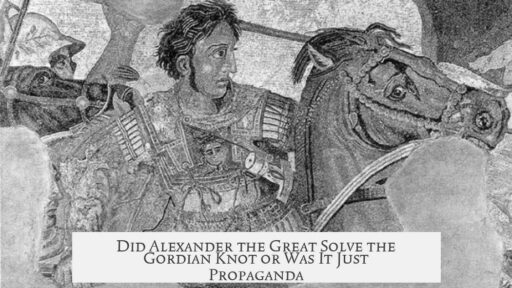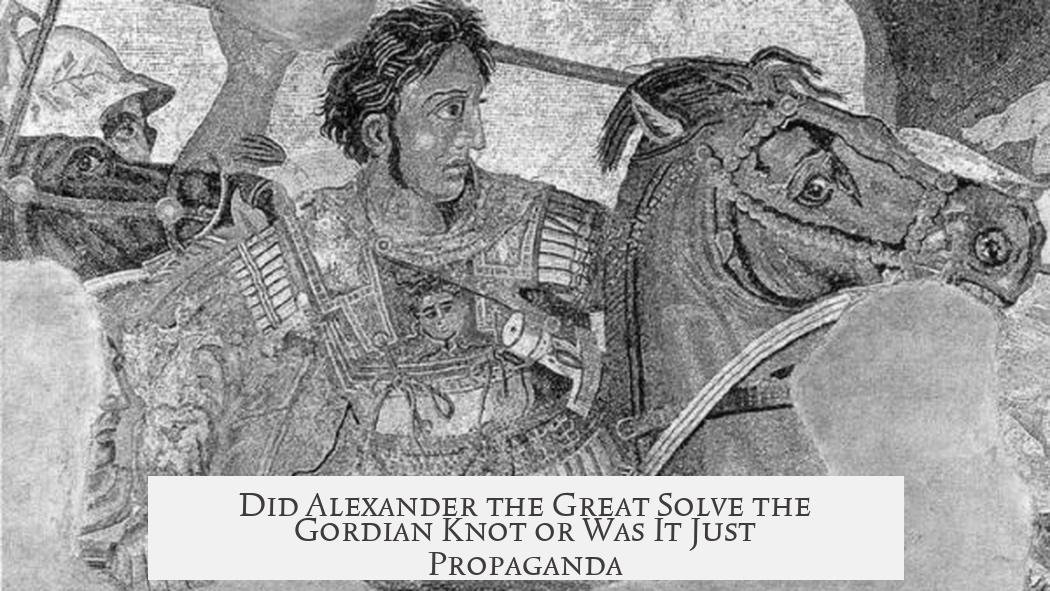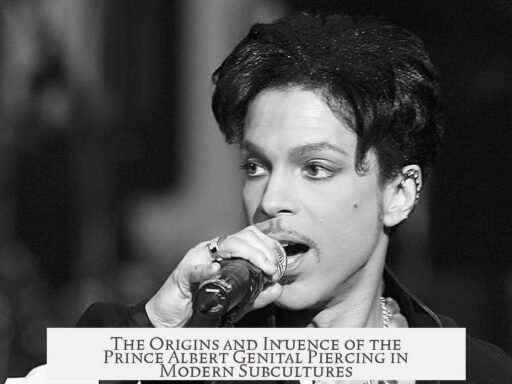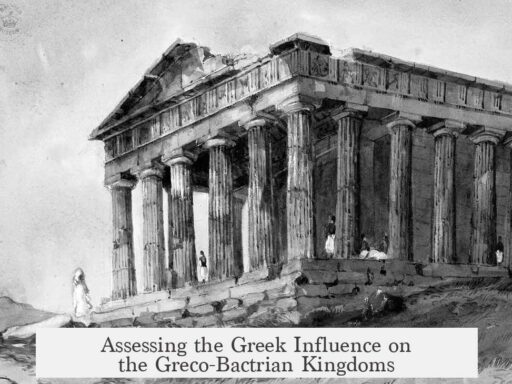Alexander the Great did indeed solve the Gordian Knot, but how he did so and the significance of the event remain unclear and likely shaped by propaganda and later myth. This episode took place in early 333 BCE during Alexander’s campaign through Asia Minor, specifically after his capture of Halikarnassos and before his further advances into Persian territory. The event is well attested in historical sources, yet details about the method Alexander used to “solve” the knot differ widely, fueling debate over its authenticity and purpose.
The Gordian Knot was a complex tangle of cords tied to a yoke on an ox-cart in the city of Gordion, Phrygia. According to prophecy, the first man to untie it would become the ruler of Asia. Alexander encountered the knot en route in his campaign, though most ancient accounts agree he did not initially seek it out because of prophecy but encountered it as a stop along his path.
Sources describing the event fall mainly into two camps. The first, including Arrian’s Anabasis of Alexander and Plutarch’s Life of Alexander, rely heavily on Aristoboulos, a pro-Alexander writer from the 2nd century BC. Aristoboulos claims that Alexander untied the knot by removing a wooden pin securing it, thus solving it in a clever, topological manner.
Contrasting this, the more dramatized version—found in both Greek and Latin sources such as Quintus Curtius Rufus and Justin—has Alexander slicing the knot with his sword. This version suggests boldness and decisiveness but is not supported by contemporary records. Instead, it likely emerged as symbolic propaganda to reflect the king’s military genius and ruthless efficiency. Some historians view this version as an embellishment designed to promote Alexander’s legendary image.
Other sources, such as Diodorus Siculus, omit the episode entirely. The absence of early or contemporary accounts raises questions about the knot’s solving as a historical event or a later invention. However, most scholars agree the event likely happened in some form, since all surviving sources attest to Alexander dealing with the knot.
The reliability of these accounts is a significant issue. Aristoboulos presents a more plausible method but is an unapologetic supporter of Alexander, possibly coloring his narrative. Arrian and Plutarch, regarded as more balanced, include multiple versions, demonstrating historical uncertainty. The sword-cutting story, popular in later retellings, is probably metaphorical rather than literal.
The prophecy linked to the Gordian Knot evolved over time. Initially, it may have been a local Phrygian legend with modest significance tied to ruling that region. By the first century AD, writers attributed broader imperial meaning to it, suggesting the one who solved it would rule all of Asia or even the inhabited world (oikoumene). This expansion of meaning likely arose to fit Alexander’s grand achievements and legitimize his conquests mythically.
Moreover, the suggestion that Alexander deliberately sought out the knot to claim this prophecy is probably a later addition. Contemporary accounts imply he encountered the knot incidentally during his military campaign. The local legend offered Alexandre a convenient symbol for asserting his dominion and providing a narrative of destiny.
In short, the Gordian Knot episode is a mixture of history and legend. Alexander solved the knot in some manner during his Asian campaign of 333 BCE, but whether he unraveled it patiently or boldly cut through it remains unknown. The dramatic sword-cutting story is largely a later embellishment intended to emphasize his decisiveness and strength. The prophecy surrounding the knot also grew in importance after the event, turning a local puzzle into a symbol of imperial destiny.
Key takeaways:
- Alexander the Great solved the Gordian Knot at Gordion during his 333 BCE Asia Minor campaign.
- Ancient sources disagree on how: either untied by removing a pin (Aristoboulos) or cut with a sword (later popular tale).
- The sword-cutting story is likely a later propaganda piece symbolizing boldness rather than a historical fact.
- The prophecy linked to the knot originally concerned local Phrygia but was later inflated to a claim over Asia or the world.
- Alexander’s encounter with the knot was incidental, not a pre-planned attempt to claim the prophecy.
- The event’s historicity is accepted, but details and meanings were shaped by myth and political messaging.
Did Alexander the Great Actually Solve the Gordian Knot or Was It Propaganda?

Yes, Alexander the Great likely solved the Gordian Knot during his campaign in 333 BCE, but whether he untied it, cut it with his sword, or simply exploited the legend is wrapped in layers of uncertainty and later propaganda. The famous episode sits at a fascinating crossroads of history and myth, leaving us with more questions than definitive answers. Let’s unravel this story—pun fully intended.
Alexander’s encounter with the Gordian Knot unfolds in a scenic, dusty corner of ancient Asia Minor. Picture this: it’s early 333 BCE. Alexander has just stormed successfully through Halikarnassos and is marching toward Gordion, the Phrygian capital. At this point, the Persian Empire, eager to thwart his advance, throws counterattacks at him.
This episode, set against a backdrop of military tension, paints Alexander as a man of destiny who came upon a tangled challenge—the Gordian Knot. Would he break this enigma to claim Asia? The story promises a grand, mythic legacy. But can the story survive scrutiny?
Multiple Versions, One Knot—How Did Alexander Actually Solve It?
The Gordian Knot tale comes to us from several ancient sources, but these accounts don’t agree on the details. That’s where the legend starts to fray.
- The Sword Story: The most popular version among ancient Greek and Latin writers tells that Alexander, faced with the impossible challenge of untying a complex knot, simply drew his sword and sliced through it. Bold? Yes. Dramatic? Absolutely. Historical? Probably exaggerated.
- The Wood Pin Solution: Aristoboulos, who lived closer to Alexander’s time and whose pro-Alexander perspective colors his writings, claims the conqueror unfastened a wooden pin holding the knot in place—an elegant, if less flashy, solution.
- Silent Sources: Some texts, like those by Diodoros, strip away the knot story altogether or provide scant detail, raising questions about the saga’s authenticity.
It’s worth noting that later historians, such as Arrian and Plutarch, present both main versions but seem unsure which to endorse. That ambivalence counts for something; they’re telling us this knotty story is tangled in its own way.
Propaganda or Bold Reality?
When considering the reliability of these accounts, one must ask: how much of this story is historical fact, and how much is crafted legend? Alexander was a master of shaping his image—propaganda was his secret weapon almost as much as his phalanx.
None of the contemporary records from Alexander’s own time confirm the sword-cutting episode. Instead, this version crops up in later sources, possibly to project Alexander as a decisive, almost superhuman figure, who solves problems by sheer force. The dramatic slash of the sword serves as a symbol, a cinematic moment etched into the legend.
Aristoboulos’s version, offering a clever unraveling of the knot instead of a brute force attack, might be an attempt to portray Alexander as not only strong but also intellectually gifted—combining strength with wisdom. The fact that Arrian and Plutarch put that theory second suggests they regard it as plausible but still debatable.
So, is the sword story an embellishment? Most scholars think yes. Still, everyone agrees Alexander did solve the puzzle in some way—just not with the guaranteed clearness of historical certainty we might prefer.
The Myth and Its Growing Significance
The Gordian Knot story didn’t just remain a neat military anecdote. Over centuries, it morphed into a symbol of destiny and imperial power. This knot supposedly held a prophecy: whoever untied it would rule the “oikoumene”—the inhabited world.
But even this prophecy has competing versions. Plutarch tells us Alexander would rule the whole world. Arrian, Curtius, and Justin mention rulership over Asia only. Earlier still, some argue the prophecy related purely to Phrygia itself, making it more localized and less grandiose than later tells suggest.
Moreover, historical accounts agree that Alexander stumbled on Gordion because it lay on his path—not because he went there deliberately to pursue the prophecy. That narrative—that Alexander intentionally chased the knot to legitimize his conquest—appears much later, likely shaped by writers eager to amplify his legendary status. By the time Justin recorded the tale, the knot had become a symbol of manifest destiny.
As scholar Paul Roller notes, the Gordian Knot seems to have started life as a local legend and was later inflated into a sweeping symbol. Alexander’s “solving” of it became a stage prop for his imperial ambitions—perhaps conveniently used by him, but certainly magnified by posterity.
What Can We Conclude?

Piecing the puzzle together, scholars agree on a few key points:
- Alexander encountered the Gordian Knot during his campaign in 333 BCE at Gordion.
- He solved the knot by some means—whether by cutting it with a sword, carefully untying it, or something else remains unclear.
- There is no strong evidence Alexander sought out the knot because of any prophecy before he arrived.
- The story evolved over time, gaining mythic weight to bolster Alexander’s image as a destined ruler of Asia or even the world.
Even the more obscure fragments, like the so-called Makedonika of Marsyas—potentially a primary source—do not settle the question beyond doubt. The scant references we have testify to an event that mattered but whose details faded, tangled in the fog of ancient storytelling.
Why Does This Matter Today?
Understanding the Gordian Knot story’s layers helps us grasp how historical figures can be transformed into legends. It shows how dramatic episodes can be shaped to fit an emerging narrative—Alexander the Great as the bold, unstoppable conqueror.
It also invites modern readers to ask critical questions: When does history end and myth begin? How do stories reflect societal values, ambitions, or propaganda needs?
In a way, Alexander’s knot is a metaphor for history itself. Trying to untangle it requires not just brute force but patience, skepticism, and an eye for the story beneath the story.
Final Thoughts—Cut Through the Noise or Smart Unraveling?
So, did Alexander really “solve” the Gordian Knot? Yes, but how exactly? The sword-cutting tale may be a dramatic flourish added later. The undoing by a hidden pin may be closer to truth—or it might be the polished version of a story meant to impress. We cannot know for sure.
One thing stands: Alexander’s act, whether brave slash or clever untangling, became an enduring symbol of boldness and destiny. And that legacy, tangled or sliced, lives on.
Next time you hear someone talk about a “Gordian Knot” in life or business, remember: sometimes the simplest solution isn’t untying it but recognizing the story we tell ourselves about the knot in the first place.




